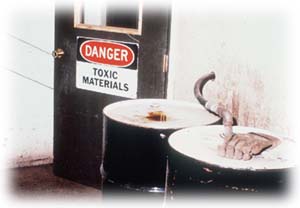Toxicity of Chemicals
Reaction and Interaction: What if You're Exposed to More Than One Chemical?
Depending upon the job you have, you may be exposed to more than one chemical. If you are, you need to be aware of possible reactions and interactions between them.
Reaction: A reaction occurs when chemicals combine with each other to produce a new substance. The new substance may have properties different from those of the original substances, and it could be more hazardous. For example, when household bleach and lye (such as a drain cleaner) are mixed together, highly dangerous chlorine gas and hydrochloric acid are formed.

Interaction: An interaction occurs when exposure to more than one substance results in a health effect different from the effects of either one alone.
Synergism: One kind of interaction is called synergism, a process in which two or more chemicals produce an effect that is greater than the sum of their individual effects. For instance, carbon tetrachloride and ethanol (drinking alcohol) are both toxic to the liver. If you are overexposed to carbon tetrachloride and drink alcohol excessively, the damage to your liver may be much greater than the effects of the two chemicals added together.
Potentiation: This interaction occurs when an effect of one substance is increased by exposure to a second substance which would not cause that effect by itself. For example, although acetone does not damage the liver by itself, it can increase carbon tetrachloride's ability to damage the liver.
Sensitivity: Are Some People More Affected Than Others?
Yes. People vary widely in their sensitivity to the effects of a chemical. Many things determine how an individual will react to a chemical. These include age, sex, inherited traits, diet, pregnancy, state of health and use of medication, drugs or alcohol. Depending on these characteristics, some people will experience the toxic effects of a chemical at a lower (or higher) dose than other people.
People may also become allergic to a chemical. These people have a different type of response than those who are not allergic. This response frequently occurs at a very low dose. Not all chemicals can cause allergic reactions. Substances that are known to cause allergies are called allergens, or sensitizers.
For example, formaldehyde gas is very irritating. Everyone will experience irritation of the eyes, nose, and throat, with tears in the eyes and a sore throat, at some level of exposure.
All people will experience irritation if exposed to high enough levels.
A person may be more sensitive to formaldehyde and have irritation at low levels of exposure. Formaldehyde also occasionally causes allergic reactions, such as allergic dermatitis, or hives.
A few people may be allergic to formaldehyde and develop hives at very low levels, although most people will not get hives no matter how much they are exposed to formaldehyde.
Knowledge Check Choose the best answer for the question.
3-6. A process in which two or more chemicals produce an effect that is greater than the sum of their individual effects is called _____.
You forgot to answer the question!
